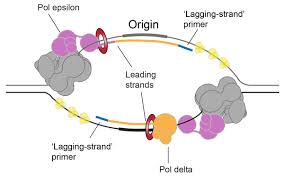Unit 1: DNA Lecture 2: DNA Function & DNA Replication
1/25
There's no tags or description
Looks like no tags are added yet.
Name | Mastery | Learn | Test | Matching | Spaced |
|---|
No study sessions yet.
26 Terms
DNA Structure
The arrangement of nucleotides in a double helix, consisting of sugar-phosphate backbones and nitrogenous bases.
Rosalind Franklin
Scientist who used X-ray crystallography to identify the structure of DNA, revealing the sugar-phosphate backbones and nitrogenous bases.
Chargaff's Rules
The principle stating that in DNA, the amount of adenine (A) equals thymine (T) and the amount of guanine (G) equals cytosine (C).
Watson-Crick Base-Pairing
The pairing of adenine with thymine and guanine with cytosine in DNA, contributing to the uniform thickness of the double helix.
DNA Function
The role of DNA in storing genetic instructions for replication and protein synthesis.
DNA Replication
The process by which DNA is copied to ensure each new cell has the same genetic information.
Semiconservative Model
The method of DNA replication where each new double helix consists of one old parental strand and one newly formed daughter strand.
Origin of Replication (ORI)
The specific location on the DNA where replication begins, leading to the formation of replication bubbles.

Leading Strand
The DNA strand that is synthesized continuously towards the replication fork during DNA replication.
Lagging Strand
The DNA strand that is synthesized discontinuously away from the replication fork, forming Okazaki fragments.
Okazaki Fragments
Short segments of DNA synthesized on the lagging strand during DNA replication.
DNA Polymerase
The enzyme responsible for adding nucleotides to the growing DNA strand during replication.
DNA Ligase
The enzyme that links Okazaki fragments together to form a continuous DNA strand.
Proofreading Ability
The function of DNA polymerase to ensure correct base pairing and repair DNA damage during replication.
Speed of DNA Replication
The rapid process of DNA copying, essential for cell division and organismal growth.
What are the 3 major functions of DNA in the cell?
Genetic instructions for making more DNA: DNA carries the instructions needed for its own replication, allowing cells to create new, identical DNA molecules. This happens during the process of DNA replication
Genetic instructions for making proteins: DNA is the template for RNA synthesis during transcription, which is then used to produce proteins during translation. This is part of the central dogma of molecular biology: DNA → RNA → Protein
Inheritance: DNA contains the genetic information passed from parents to offspring, ensuring traits and characteristics are inherited
What insights into DNA structure did Chargaff contribute?
Erwin Chargaff:
Discovered that in any DNA sample, the number of adenine (A) molecules equals the number of thymine (T) molecules, and the number of guanine (G) molecules equals the number of cytosine (C) molecules. This is known as Chargaff's Rules
Showed that %A = %T and %G = %C, which is key for understanding base pairing
What did Franklin contribute?
Used X-ray crystallography to identify the structure of DNA. She showed that the sugar-phosphate backbone is on the outside of the helix, and the nitrogenous bases are inside(Lecture 2 - DNA Functio…).
Franklin's work also revealed that DNA has a uniform diameter of 2nm, which contributed to understanding how the two strands form a double helix
What insights did Watson and Crick contribute to their “model” or description of DNA structure?
Built a model of DNA that aligned with the experimental data from Franklin, Chargaff, and others. Their model showed that DNA is a double helix where a purine (A or G) pairs with a pyrimidine (T or C) to maintain a consistent width.
They proposed the concept of complementary base pairing, where A pairs with T and G pairs with C.
Their model was crucial for explaining how DNA could replicate and transmit genetic information accurately, and they were awarded the Nobel Prize for this discovery.
How is DNA replicated in a cell?
Steps of DNA replication:
Separation of the two strands: Enzymes such as helicase unwind the DNA and separate the two strands at the origin of replication.
Formation of new strands: DNA polymerase adds complementary nucleotides to the template strand, following the base-pairing rules (A-T, G-C)).
Sugar-phosphate backbone: The enzyme DNA polymerase also helps form the sugar-phosphate backbone by creating phosphodiester bonds between nucleotides.
Semiconservative replication: Each new DNA molecule consists of one old (parental) strand and one newly synthesized (daughter) strand.
What enzymes are involved? What is the role/contribution of each?
Helicase: pry apart helix/double stranded DNA (breaks hydrogen bonds)
Topoisomerase: unwinding DNA
DNA Polymerase: Adds nucleotides to the growing DNA strand and proofreads to ensure correct base pairing.
Ligase: Joins together fragments of DNA, such as the Okazaki fragments on the lagging strand.
Why does replication of the two strands go in opposite directions
DNA polymerase can only add nucleotides in the 5' to 3' direction. Therefore, the leading strand is synthesized continuously in the direction of the replication fork, while the lagging strand is synthesized in Okazaki fragments moving away from the fork
What is the main purpose of DNA replication? What are 2 reasons why DNA would replicate?
To make an exact copy of DNA so that each new cell has a complete set of genetic instructions
Reasons for DNA replication:
Organismal growth: As organisms grow, they need more cells, and each cell needs its own copy of DNA
Wound repair: When tissues are damaged, new cells are needed to replace those that were lost, which requires DNA replication
Why is DNA replication said to be semi-conservative? What is the value of this to the cell?
Semi-conservative: Each new DNA molecule consists of one parental strand and one newly synthesized daughter strand
Value: This method ensures that each new DNA molecule is identical to the original, preserving genetic information across generations